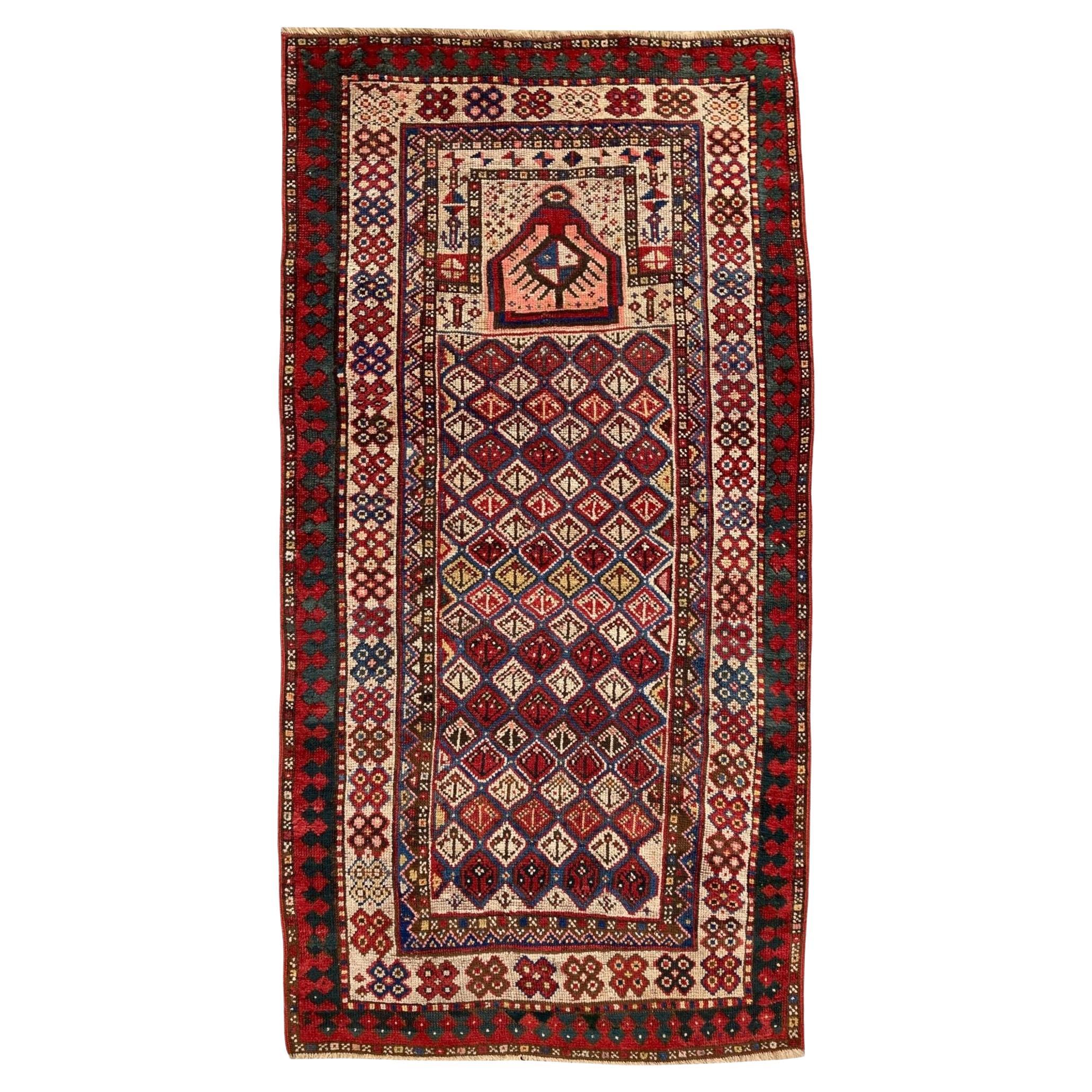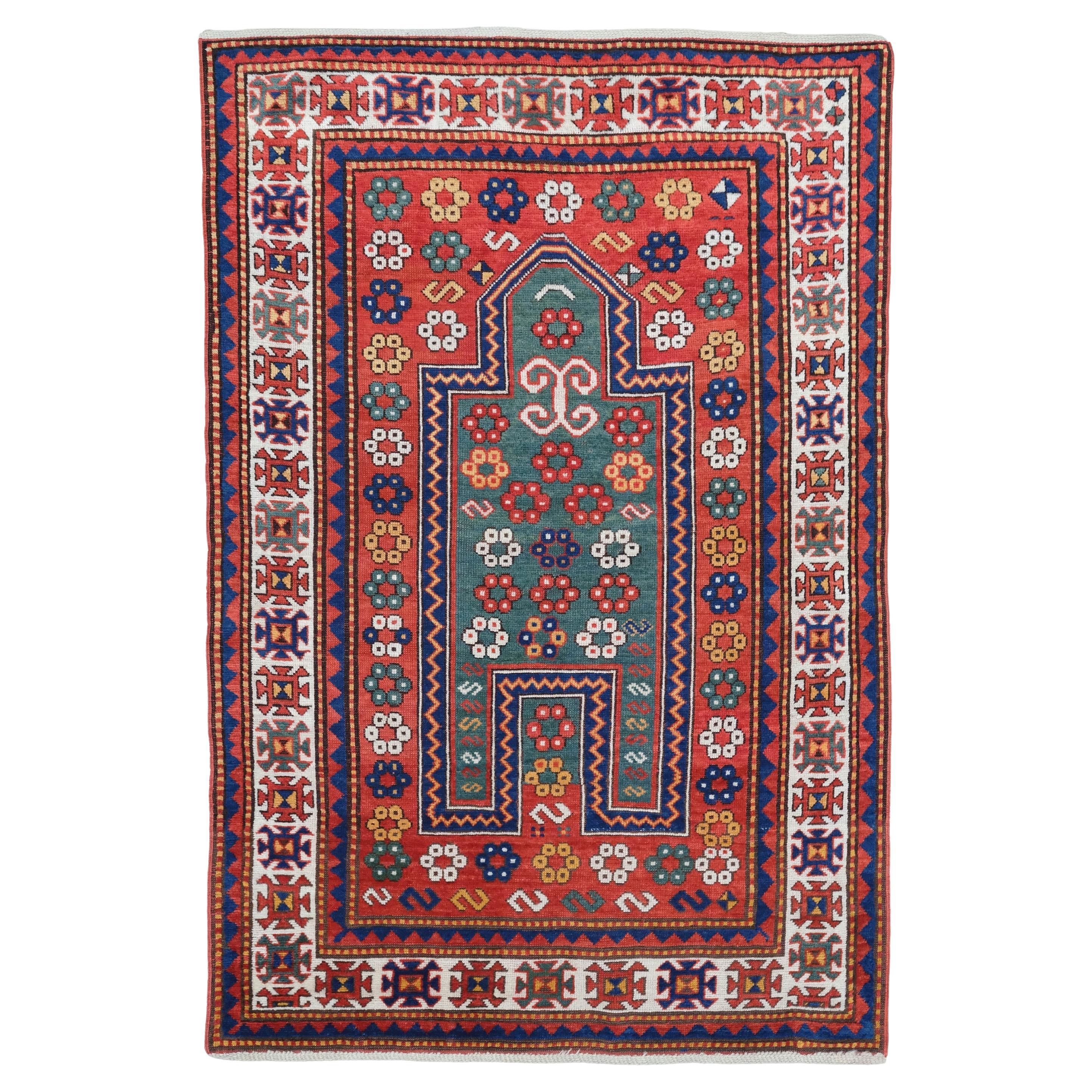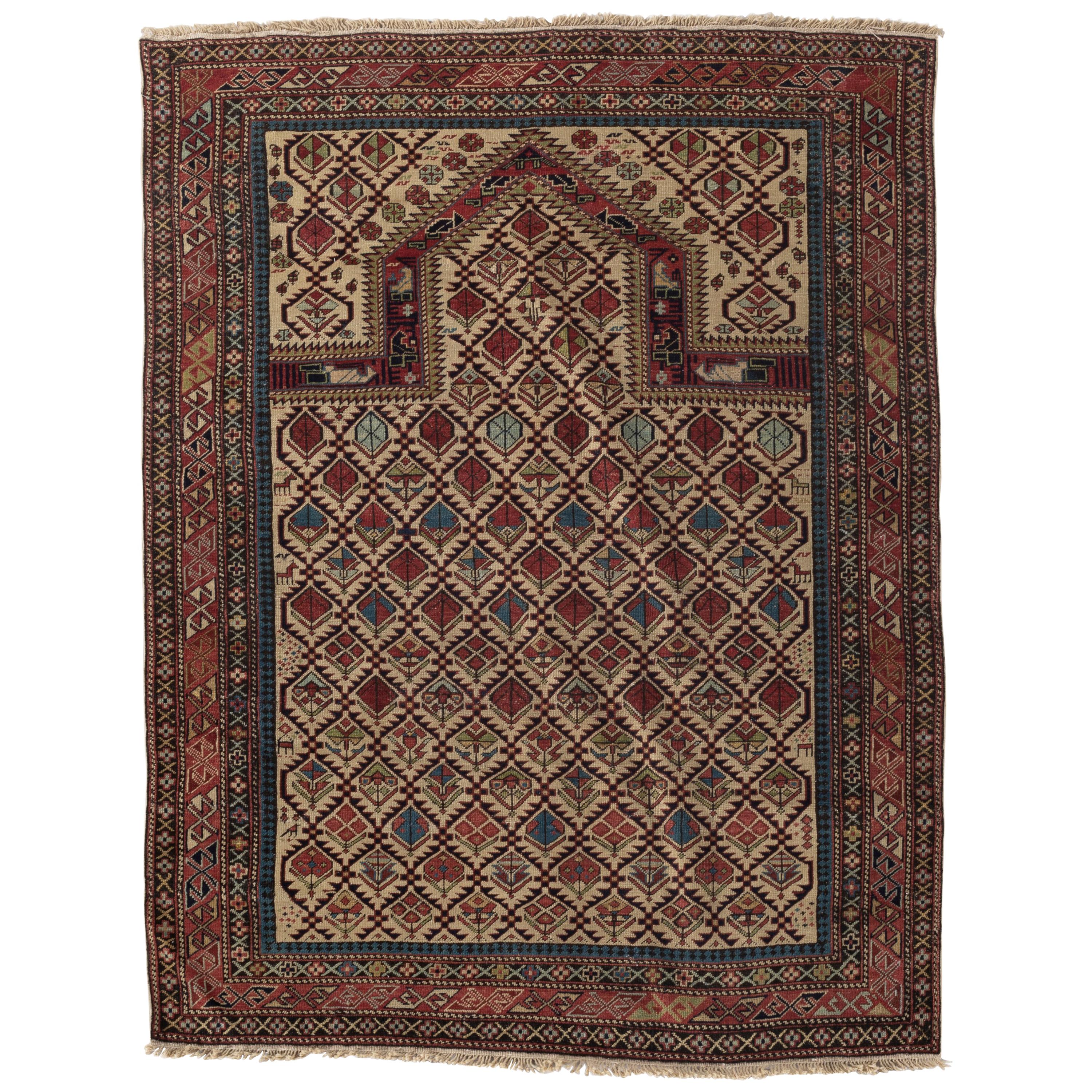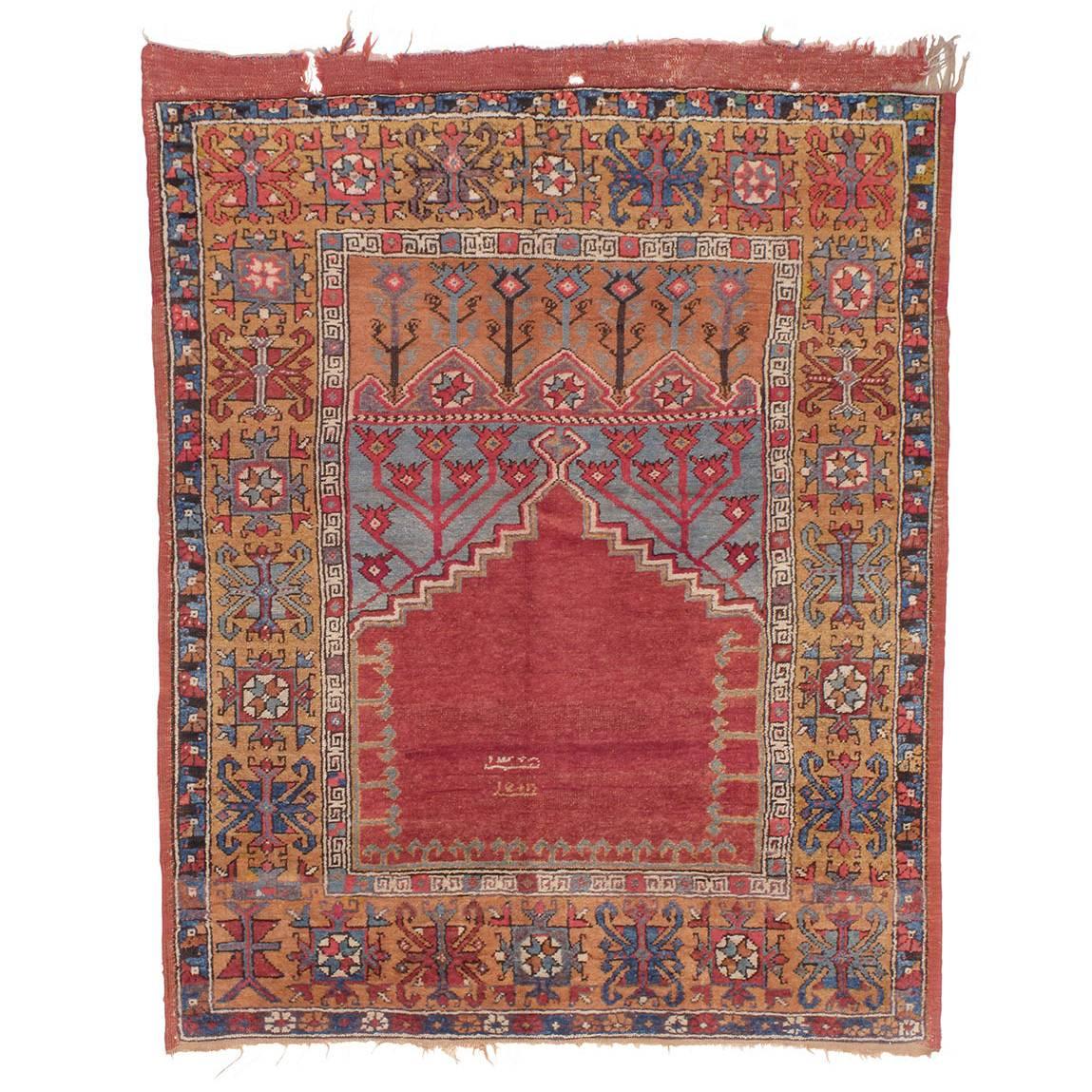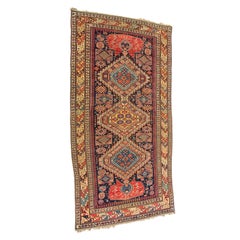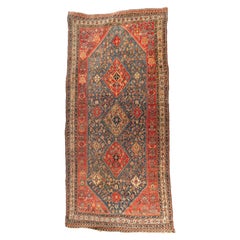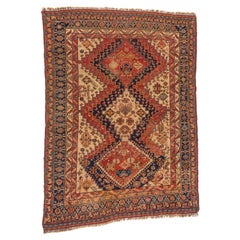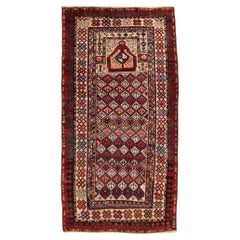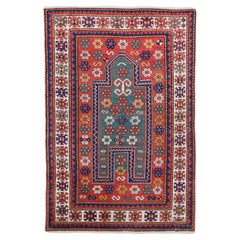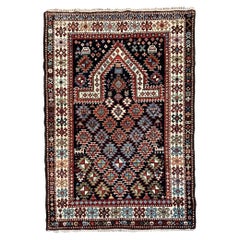Items Similar to Antique Long Gendje Caucasian Prayer Rug
Want more images or videos?
Request additional images or videos from the seller
1 of 9
Antique Long Gendje Caucasian Prayer Rug
$1,680
£1,274.75
€1,457.56
CA$2,346.50
A$2,608.99
CHF 1,362.27
MX$31,757.81
NOK 17,382
SEK 16,286.11
DKK 10,878.02
Shipping
Retrieving quote...The 1stDibs Promise:
Authenticity Guarantee,
Money-Back Guarantee,
24-Hour Cancellation
About the Item
An unusually long prayer rug – and comparatively rare Gendje – in good condition. Above average centre field variation of colour and a particularly lively top Mihrab area to place in the direction of Mecca. The interior border with eight to ten consecutive colour and design variants in the hexagonal figures attest to its age, detail and collectibility. A very good example for the price.
About the Seller
No Reviews Yet
Vetted Professional Seller
Every seller passes strict standards for authenticity and reliability
1stDibs seller since 2022
- ShippingRetrieving quote...Shipping from: WYNNUM, Australia
- Return Policy
Authenticity Guarantee
In the unlikely event there’s an issue with an item’s authenticity, contact us within 1 year for a full refund. DetailsMoney-Back Guarantee
If your item is not as described, is damaged in transit, or does not arrive, contact us within 7 days for a full refund. Details24-Hour Cancellation
You have a 24-hour grace period in which to reconsider your purchase, with no questions asked.Vetted Professional Sellers
Our world-class sellers must adhere to strict standards for service and quality, maintaining the integrity of our listings.Price-Match Guarantee
If you find that a seller listed the same item for a lower price elsewhere, we’ll match it.Trusted Global Delivery
Our best-in-class carrier network provides specialized shipping options worldwide, including custom delivery.More From This Seller
View AllAntique Melas Turkish Prayer Rug
Located in WYNNUM, QLD
This is admittedly a collector’s piece, for a connoisseur. Melas rugs became known and appreciated in Europe as early as 1700, though its history of weaving goes back at least severa...
Category
Antique Early 19th Century Turkish Turkish Rugs
Materials
Wool
Antique 1880 Shirvan Caucasian investment carpet . rare, excellent condition
Located in WYNNUM, QLD
From a Philadelphia Collector
This is a very robust member of the esteemed, and increasingly rare 19th century Afstaka “family”. It is slightly longer and wider than many exam...
Category
Antique 1870s Azerbaijani Caucasian Rugs
Materials
Wool
Antique Gashgai Long Rug
Located in WYNNUM, QLD
This finely detailed Qashgai, over 100 years old is unusual as to its length as well as its elegance, achieved within the pattern language typical of this celebrated Persian tribe. E...
Category
Vintage 1910s Persian Persian Rugs
Materials
Wool
$4,200
Unusually Fine Qashgai'i 1870 Antique Tribal rug short term reduction
Located in WYNNUM, QLD
Qashgai circa 1870-80
Qashgai, UNUSUALLY FINE ANTIQUE TRIBAL PIECE circa 1870 - 1880
3 x 5 ft
Acquired from a French dealer
The Qashgai Federation...
Category
Antique 1870s Persian Persian Rugs
Materials
Wool
Hard to Find Rich oversize TABRIZ PRAYER RUG ANTIQUE , SHORT TERM REDUCTION
Located in WYNNUM, QLD
Tabriz Prayer Rug circa 1900
4.1 feet x 5.8
Acquired from an Istanbul dealer
A strange mystery exists. Why are the vast majority of prayer rug...
Category
Antique Early 19th Century Persian Persian Rugs
Materials
Wool
High Collectible 19th Century Ferahan Sarouk, Princely, at Short Term Reduction
Located in WYNNUM, QLD
Ferahan Sarouk Museum Quality
MUSEUM QUALITY Ferahan Sarouk, third quarter 19th century
6.6 x 4.5 feet
From a USA collector
Ferahan Sarouk carpets produced around the wider Arak (formerly Sultanabad) area from about 1850-1910 earned a deserved reputation as amongst the most desirable and imaginative finely woven carpets in Persia. As these things go, they morphed in style around 1910- 1920 into the differently woven Mahajirhan Sarouk fashion (quality examples of which are also in demand) and then disappeared entirely.
Their desirability rests not only on fine weaving, and excellent wool. Many of the better examples were commissioned by aristocrats or wealthy merchants who encouraged creativity, in an actively competitive way; rugs during this period, as before, were direct illustrations of an individual’s wealth, power and prestige.
Beyond this lay a more fundamental and seemingly contradictory set of motivations by the weavers. At one and the same time they sought to emulate the great court carpets in finesse and design. And yet-- they applied rustic or village, and even tribal elements and nuances to their designs. The result was a cavalcade of creativity.
So, a village-based genre came into being which produced primarily an approx. 6x4 rug size format, and also provided, if more rarely, larger formats, which command increasingly high prices, due to their rarity, visual excitement and grandeur.
The artistic achievement of this “school” had to do with marrying elegance and a degree of formalism with whimsy, and design innovation. They offer a charm and a certain magic beyond that of court and most city carpets.
As in any area or era, there is a quality spectrum ranging from mediocre to highly superior. Superiority is judged of course as to weave and wool quality. It is rather unusual, though, to encounter pieces made before 1890 -which are bona fide Ferahan Sarouks- with poor wool or weaving: standards were upheld during this period, and natural dyes were widely employed, particularly in the wider Arak (then Sultanabad) region.
Thus, as an investment collectible to adorn the home we believe the ultimate criterion is aesthetics, this being an art form, after all.
Ferahan Sarouks have been a special area of interest for us over the decades both from artistic and investment perspectives.
Allowing for personal taste, our suggestions are few and simple. A Ferahan Sarouk ought to display a wide colour palette, fine drawing and delicate, sometimes “intense “ detail. The finest pieces also display an elevated sense of balance in the use of space.
We have seen many finely woven pieces which in our view are garish and lack one of the two key artistic elements intrinsic to the better examples of this genre – elegance. Sometimes they are overly cluttered; the drawing artistry is muddled or lost. In other cases odd and ineffective design devices are used, detracting from or interfering with an otherwise good design. The era of the Ferahan Sarouk was rife with experiments, not all of them successful.
The other important attribute, when it can be found, is original artistic creativity, even serendipity, -- or effective design innovation within the compass of this rug type and the unique standards of its prime period.
On average, we examine between 30-40 antique Ferahan Sarouks to achieve one acquisition, for the benefit of our clients.
This highly collectible more than 150-year-old carpet is an apex achievement of superior artistry and innovation. As an exemplar of its genre, it can be reasonably described as Museum quality, a term we do not often employ.
Please observe the stunning precision of the inner guard and its pinpoint sharp hooks. The elongation of the central medallion is one of its subtle but powerful innovations in form. The nod to asymmetry – which displays a refined sense of humour - is seen in the use of the small diamond figures, as one is deliberately missing from the right hand side: a wry nod to asymmetry, in an otherwise perfectly symmetrical creation.
The ultimate achievement here is in the fineness of the weaving itself, on close inspection. The herati pattern in the medallion and corners achieves an etched-on quality, a very uncommon level of attention to detail and perfectionism: clearly the work of a master. This artistic sense extends to the outer ground which is a superb example of the most subtle abrash, one of the most refined we have had the honor of viewing. The unusual beige/brown tones in the field were probably achieved by adding onion skins to the die vat. These extremely fine gradations of colour are rarely seen.(NB the colour photographs create a slightly misleading- overly yellow burnish to the field colour in spite of expert photographic efforts ) .
The deliberate choice of an ink black use of indigo provides a powerful frame (border) for this piece of art, which note in the lower right-hand corner is lifted slightly through abrash to a deep blue – to highlight the design and use of emerald green in the rosettes. The green shades lighten as the border ascends harmonizing with the tones in the central medallion.
The floating flow of flowers in the border is beautifully executed, with up to seven colours in a single figure.
No doubt a piece commissioned by an aristocrat around 1870, it is – remarkably- in virtually perfect condition. It appears to have had very minimal footwear, and great care; a piece which was proudly displayed from time to time and appreciated. Its density and strong foundation would however allow regular use within a home, and in a spacious contemporary home or office could make a wall hanging of striking impact.
This remarkable one of a kind piece is on short term reduction to coincide with our launch on 1st Dibs . Fair market value is approximately $22,000 .
Fine art as investment ? The WSJ made the following comments this year :
The vigor of the art market may seem counterintuitive, but it makes sense in the current environment,” economist Tyler Cowen recently wrote in The Washington Post. “First, many of the wealthy have been buying additional homes and wish to furnish them with art. Second, the recent run-up in inflation rates around the world has intensified the search for hedges.”
While the aforementioned artworks fall into traditional categories, some less-prominent forms of fine art also represent ideal investment opportunities, especially because they offer more attractive—i.e., significantly less costly—entry points for new collectors. Take high-collectible and connoisseur-caliber antique Oriental rugs, for example. The best 19th-century examples often sell privately between five figures and low six figures.
Today, that obscurity is fading. According to Ben Evans, the editor of Hali Magazine—a publication dedicated to the international rug and textile market—there are two primary factors to explain why antique rugs are beginning to enjoy their moment in the spotlight. “Cultural curiosity and collecting...
Category
Antique 1880s Persian Persian Rugs
Materials
Wool
You May Also Like
Antique Caucasian Gendje Prayer Rug 1.90m X 0.98m
Located in St. Albans, GB
A beautiful little antique Gendje rug, handwoven in The Caucasus mountains of modern day Azerbaijan circa 1890. It features an unusual prayer rug design on a multicoloured lozenge fi...
Category
Antique 1890s Azerbaijani Caucasian Rugs
Materials
Wool
Antique Marashali Prayer Rug - Late 19th Century Prayer Marasali Rug
Located in Sultanahmet, 34
Late of the 19th Century Caucasian Prayer Marasali Rug
Size : 115 x 143 cm
This impressive late 19th-century Caucasian Marashali Carpet is a masterpiece ...
Category
Antique Late 19th Century Caucasian Caucasian Rugs
Materials
Wool
Caucasian Fahrola Prayer Rug - 19th Century Fahrola Prayer Rug
Located in Sultanahmet, 34
This antique Fahrola rug dates from the 19th century and stands out with its rich color palette and detailed patterns. In the middle of the carpet, there is a mihrab pattern decorate...
Category
Antique 19th Century Caucasian Caucasian Rugs
Materials
Wool
Antique Caucasian Prayer Rug 1.51m x 1.03m
Located in St. Albans, GB
A beautiful little antique pryer rug, handwoven in The Caucasus mountains, possibly in Dagestan, circa 1900. It features a traditional Mihrab design on a deep indigo lozenge field wi...
Category
Antique Early 1900s Caucasian Rugs
Materials
Wool
Antique circa 1880 Caucasian Dagestan Prayer Rug
Located in Secaucus, NJ
Antique circa 1880 Caucasian Dagestan Prayer rug. The delightful floral elements on the ivory ground together with the multiple borders in a variety of designs styles and colors crea...
Category
Antique 19th Century Caucasian Caucasian Rugs
Materials
Wool
Antique Konya Prayer Rug
Located in New York, NY
Antique Konya Prayer rug. A beautiful antique rug from central Turkey, in a distinct prayer rug style attributed to the small hamlet of Inlice, southw...
Category
Antique Late 19th Century Turkish Tribal Turkish Rugs
Materials
Wool
$4,760 Sale Price
20% Off
More Ways To Browse
Scandinavian Swedish Kilim
Century Furniture Company End Table
Marble Coffee Table Used
Mid Century Wall Tapestry
Swiss Leather Furniture
Mahogany Antique Desks Mahogany Desks
Sculptural Small Table
Light Wood Coffee Table
Mid Century Easy Chair
Black Leg Coffee Table
Solid Black Walnut Table
Antique Glass Finials
Red Desk
Vintage Hand Painted Glasses
Brass Clad
Elm Antique Furniture
New York Travel Posters Vintage
Large Stained Glass
